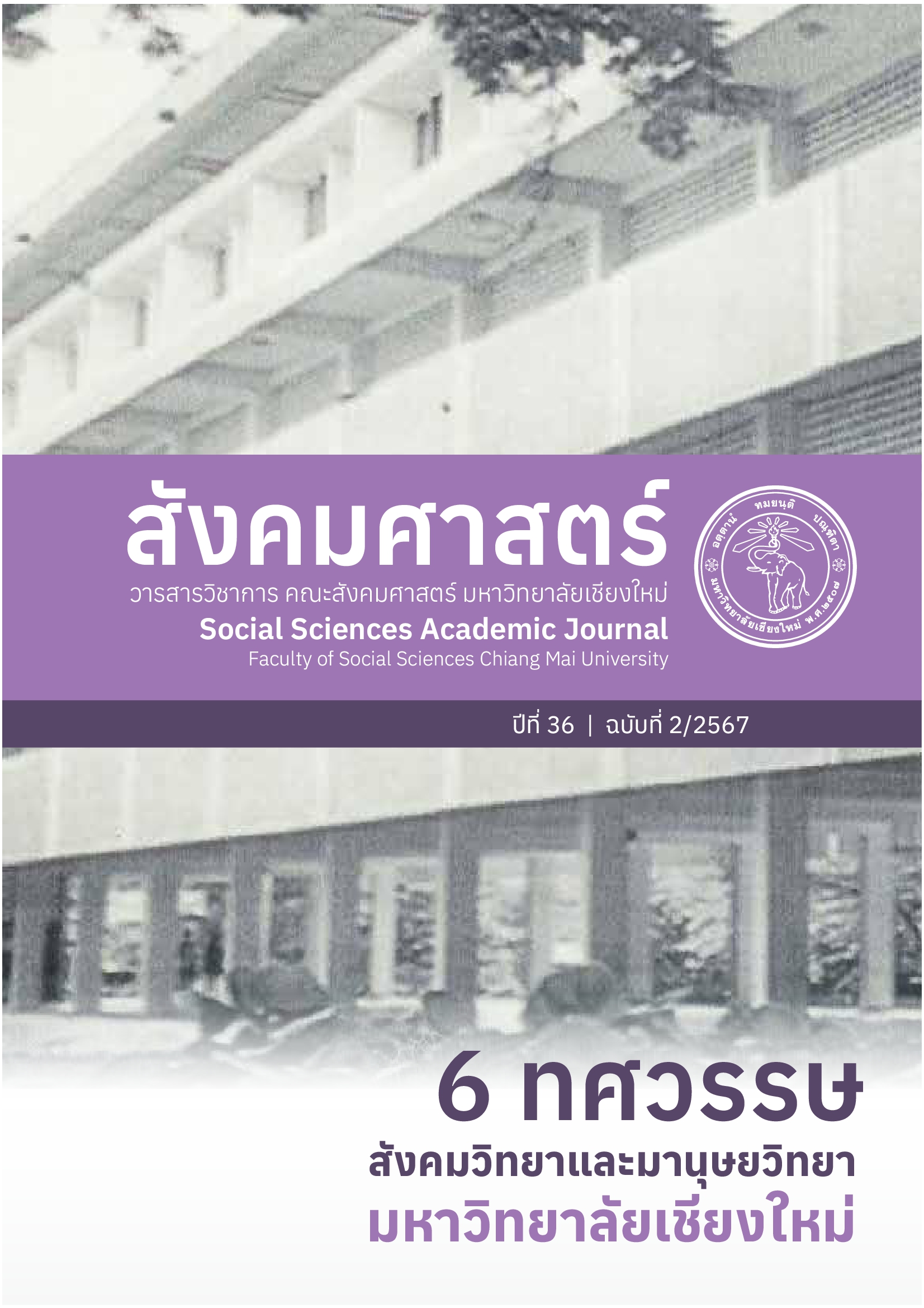A Phenomenological Study of Destitute Students’ Learned Helplessness Amphoe Ban Fang, Khon Kaen Province
Main Article Content
Abstract
This research employed qualitative research based on phenomenology. The overarching aim of the study was to study the characteristics of learned helplessness among impoverished students through the lens of phenomenology. In this study, the key informants, who provided firsthand experiences and comprehensive data on the studied phenomenon, consisted of a total of four students. The data were collected through in-depth interviews and observations of phenomena in the research area. The instruments used in the research included: personal interview data recording form, in-depth interview question, field notes, and audio recorders. Data analysis followed Seligman’s theory of depression components. The research results reveal that the characteristics of hopelessness among impoverished students are as follows: 1) cognitive deficits, including a diminished sense of ability, 2) motivational deficits, consisting of: 2.1 periods of regression, 2.2 repetitive behavior, 2.3 social bullying, and 3) emotional deficits, consisting of: 3.1 feelings of inferiority, 3.2 emotional outbursts. Additionally, socio-economic status emerged as a critical factor contributing to the development of learning helplessness in impoverished students. Furthermore, the research identified key experiences associated with student hopelessness: 1) experiences of parental divorce, 2) experiences with guardians involved in gambling or substance abuse, 3) the loss of a family leader or primary provider, and 4) experiences of coercion. These findings suggested that students felt demotivated in their studies due to a lack of family support, financial resources, emotional warmth, and parental engagement in their education. These conditions negatively impacted students' self-perception, leading to feelings of incompetence and hopelessness about life, and diminishing the value they place on education. This study highlighted the need for educators and stakeholders to deeply understand each individual student, providing opportunities and support for students to showcase their abilities. Teachers, as vital intermediaries, should help create a nurturing environment that fosters warmth and inspiration, instilling positive attitudes and an optimistic worldview in students. This will ultimately lead to the development of students as potential individuals who can contribute positively to society.
Article Details

This work is licensed under a Creative Commons Attribution-NonCommercial-NoDerivatives 4.0 International License.
All written articles published on Journal of Social Sciences is its author’s opinion which is not belonged to Faculty of Social Sciences, Chiang Mai University or is not in a responsibility of the journal’s editorial committee’s members.
References
กระทรวงศึกษาธิการ. 2542. คำชี้แจงประกอบพระราชบัญญัติการศึกษาแห่งชาติ. กรุงเทพฯ : โรงพิมพ์
กรมศาสนา.
______________. 2542. แนวคิดและนโยบายการทรวงศึกษาธิการพื้นฐานการปฏิรูปการศึกษาเพื่อ ประชาชน. กรุงเทพ ฯ : โรงพิมพ์คุรุสภาลาดพร้าว.
______________. 2542. แนวทางการดำเนินงานการปฏิรูปการศึกษา. กรุงเทพ ฯ : โรงพิมพ์คุรุสภา
ลาดพร้าว.
กัลยรัตน์ กล่ำถนอม. 2547. “การพัฒนาศักยภาพคนจนเมืองในทศวรรษหน้า (พ.ศ.2547-2557).”
วิทยานิพนธ์. ปริญญามหาบัณฑิต.มหาวิทยาลัยธรรมศาสตร์.
จำเนียร์ สตารเขต. 2541. “การศึกษาภูมิหลังทางครอบครัว สภาพปัญหา และสาเหตุของนักเรียนที่เข้ารับ
การปรึกษาในโครงการโรงเรียนตัวอย่าง ทางสุขภาพจิต ศูนย์สุขวิทยาจิต.” กรุงเทพฯ : ศูนย์สุขวิทยา จิต กรมสุขภาพจิต กระทรวงสาธารณสุข.
ชมพูนุท ศรีจันทร์นิล. 2560. “การวิเคราะห์เชิงปรากฏการณ์วิทยาแบบตีความ: ระเบียบวิธีวิจัยเชิง คุณภาพสำหรับการวิจัยทางด้านจิตวิทยา.” วารสารศึกษาศาสตร์ มหาวิทยาลัยบูรพา 28 (3): 1- 13.
ชาย โพธิสิตา. 2550. ศาสตร์และศิลป์แห่งการวิจัยเชิงคุณภาพ. พิมพ์ครั้งที่ 3. กรุงเทพฯ: อมรินทร์พริ้นติ้ง
แอนด์พับลิชชิ่ง.
ชูชิต ชายทวีป. 2559. “ปัจจัยสำเร็จของการลดปัญหาความยากจน.” วารสารสังคมศาสตร์บูรณาการ
มหาวิทยาลัยมหิดล 3 (2): 188-214.
ฐิติมา วัฒนจัง. 2556. แนวทางการบรรเทาความยากจนของเกษตรกร โดยใช้หลักเศรษฐกิจพอเพียง :
กรณีศึกษาเกษตรกรในเขตปฏิรูปที่ดิน อำเภอหนองเสือ จังหวัดปทุมธานี. กรุงเทพฯ:สำนักงานการ.
ปฏิรูปที่ดินเพื่อเกษตรกรรม.
ทิพวัลย์ สุทิน. 2542. การเสริมสร้างและพัฒนา EQ. ใน เอกสารประกอบการสัมมนา เรื่องความเฉลียว ฉลาดทางอารมณ์, กรุงเทพฯ : สมาคมแนะแนวแห่งประเทศไทย.
ธนพล สราญจิตร์. 2558. “ปัญหาความยากจนในสังคมไทย.” วารสารวิชาการมหาวิทยาลัยอิสเทิร์นเอเชีย 5 (2): 12-21.
นิษา สมานทรัพย์ และรังสิมันต์ สุนทรไชยา. 2555. “ปัจจัยคัดสรรที่มีความสัมพันธ์กับความสิ้นหวังใน ผู้ป่วยโรคซึมเศร้าวัยสูงอายุ.” วารสารการพยาบาลจิตเวชและสุขภาพจิต 26 (3): 57-70.
เบญญพร บรรณสาร. 2561. “ความสิ้นหวังของผู้รอดชีวิตจากมะเร็ง.” วารสารการพยาบาลจิตเวชและ สุขภาพจิต 32 (2): 1-12.
ปฏิพร เมฆรา. 2552. “ผลของการปรึกษาโดยการอธิษฐานแบบฟังตามความเชื่อทางคริสตศาสนาต่อ ความรู้สึกสิ้นหวัง.” เชียงใหม่: บัณฑิตวิทยาลัย มหาวิทยาลัยเชียงใหม่ . สืบค้นเมื่อ 1 มีนาคม 2567. https://cmudc.library.cmu.ac.th/frontend/Info/item/dc:110825
พัฒนโชค ชูไทย. 2563. “ปัจจัยที่ส่งผลต่อการลาออกจากโรงเรียนของนักเรียนในประเทศไทย.” วิทยานิพนธ์ ปริญญาเศรษฐศาสตรมหาบัณฑิต คณะเศรษฐศาสตร์ จุฬาลงกรณ์มหาวิทยาลัย.
วนิดา อาแว. 2560. “ปัจจัยคัดสรรที่มีความสัมพันธ์กับภาวะสิ้นยินดีของผู้ป่วยโรคซึมเศร้า เขตภาคใต้.” วิทยานิพนธ์ปริญญาพยาบาลศาสตรมหาบัณฑิต จุฬาลงกรณ์มหาวิทยาลัย.
วิทยา เจียรพันธุ์. 2549. “ปัญหาความยากจนในเกษตรกรไทย.” วารสารเพื่อการพัฒนาชนบทธนาคารเพื่อ
การเกษตรและสหกรณ์การเกษตร 9 (6): 87-116.
วิสสุตา นาโสก, ศานิตย์ ศรีคุณ. 2566. หลักสูตรแฝงว่าด้วยเรื่องกลวิธีการตีตราตนเองของนักเรียนใน สถานศึกษาขนาดเล็ก : การศึกษาเชิงปรากฏการณ์วิทยา.วารสารสังคมศาสตร์วิชาการ ปีที่ 16 (2): 50-76. คณะสังคมศาสตร์ มหาวิทยาลัยราชภัฎเชียงราย. สืบค้นเมื่อ 1 มีนาคม 2567. https://so04.tci-thaijo.org/index.php/social_crru/issue/view/17739
สุพนิดา จิระสินวรรธนะ. 2565. “ความยากจนในผู้สูงอายุไทย: การเปลี่ยนแปลงและปัจจัยเสี่ยง.” วิทยานิพนธ์ปริญญาศิลปศาสตรดุษฎีบัณฑิต วิทยาลัยประชากรศาสตร์ จุฬาลงกรณ์มหาวิทยาลัย
สุพิชชา โชติกำจร. 2564. “การศึกษาภาวะความยากจนและปัจจัยที่มีผลต่อความยากจนในประเทศไทย.” วารสารวิทยาการจัดการปริทัศน์ 23 (2): 63-71.
สำนักงานคณะกรรมการพัฒนาการเศรษฐกิจและสังคมแห่งชาติ. 2560. ดัชนีความก้าวหน้าของคนปี
กรุงเทพฯ: สำนักงานคณะกรรมการพัฒนาการเศรษฐกิจและสังคมแห่งชาติ.
สำนักงานสภาพัฒนาการเศรษฐกิจและสังคมแห่งชาติ. 2566. รายงานการวิเคราะห์สถานการณ์ความ ยากจนและความเหลื่อมล้ำในประเทศไทย ปี 2565. กรุงเทพฯ: สำนักงานสภาพัฒนาการเศรษฐกิจ และสังคมแห่งชาติ.
สำนักงานเลขาธิการสภาผู้แทนราษฎร. 2566. การศึกษาถึงปัจจัยที่ส่งผลต่อดัชนีความยากจนหลายมิติ. กรุงเทพฯ: สำนักงบประมาณของรัฐสภา สำนักงานเลขาธิการสภาผู้แทนราษฎร.
อัญญา ปลดเปลื้อง. 2556. “การวิเคราะห์ข้อมูลเชิงปรากฏการณ์วิทยา.” วารสารพยาบาลกระทรวง สาธารณสุข 23 (2): 1-10.
อารีย์วรรณ อ่วมตานี. 2559. การวิจัยเชิงคุณภาพ. พิมพ์ครั้งที่ 3. กรุงเทพฯ: โรงพิมพ์แห่งจุฬาลงกรณ์ มหาวิทยาลัย.
Beck, A. T. 1967. Depression: Clinic, experimental, and theoritical aspects. New York:
Hoeber Medical Devision.
Colaizzi P. 1978. Psychological research as the Phenomenologist views it. In Existential – Phenomenological Alternatives for Psychology (Valle R. & King M. eds), Oxford University Press, London,48-71.
Corrigan, P. 2004. “How stigma interferes with mental health care. American Psychologist,” 59 (7): 614–625. https://doi.org/10.1037/0003-066X.59.7.614. February 25, 2024.
Ellis, F. 2000. “Rural Livelihood Diversity in Developing Countries: Analysis, Method.”
Policy. Oxford University Press.
Goffman, E. 1963. Stigma. Notes on the Management of Spoiled Identity. London: Penguin Books.
Gumus, A. B., Cam, O., & Malak, A. T. 2011. Relationships between psychosocial
Adjustment and hopelessness in women with breast cancer. Asian Pacific
Journal of Cancer Prevention.
Heidegger M. Being and Time (MacQuaeeie J. & Robinson E. trans). Harper & Row, New
York. 1962.
Husserl E. Phenomenology and the Crisis of Philosophy (Lauer Q. trans.). Harper & Row,
New York. 1965.
Lindholm, L., Holmberg, M., & Makela, C. 2005. “Hope and hopelessness.” International
Journal for Human Caring 9 (4): 33-38.
Polit, D. F., & Hungler, B. P. 1999. “Nursing research principles and methods.” Phyladelphia.
Lippincott Williams and Wilkins.
Phothisita, C. 2007. “Science and Art of Qualitative Research.” 3rd ed. Bangkok: Amarin
Printing & Publishing Public (Company Limited). (in Thai).
Roger Hallowell. 1996. “The Relationship of Customer Satisfication, Customer Loyalty, and Profitability: an empirical study.” International Journal of Service Industry Management.
Seligman, M. E. P., and Csikszentmihalyi, M. 2000. “Positive psychology.” An introduction.
American Psychologist.
Shives, L. R., & Isaacs, A. 2002. Basic concept of psychiatric-mental health nursing (5th
ed.). Philadelphia: Lippincott.
Streubert, H.J., and Carpenter, D.R. 1995. “Qualitative Research in Nursing.” Philadelphia J.B. Lippincott Company.
Tai, T., & Treas, J. 2009. “Does household composition explain welfare regime poverty risks for older adults and other household members.” Journals of Gerontology Social Sciences 64B (6): 777–787.


